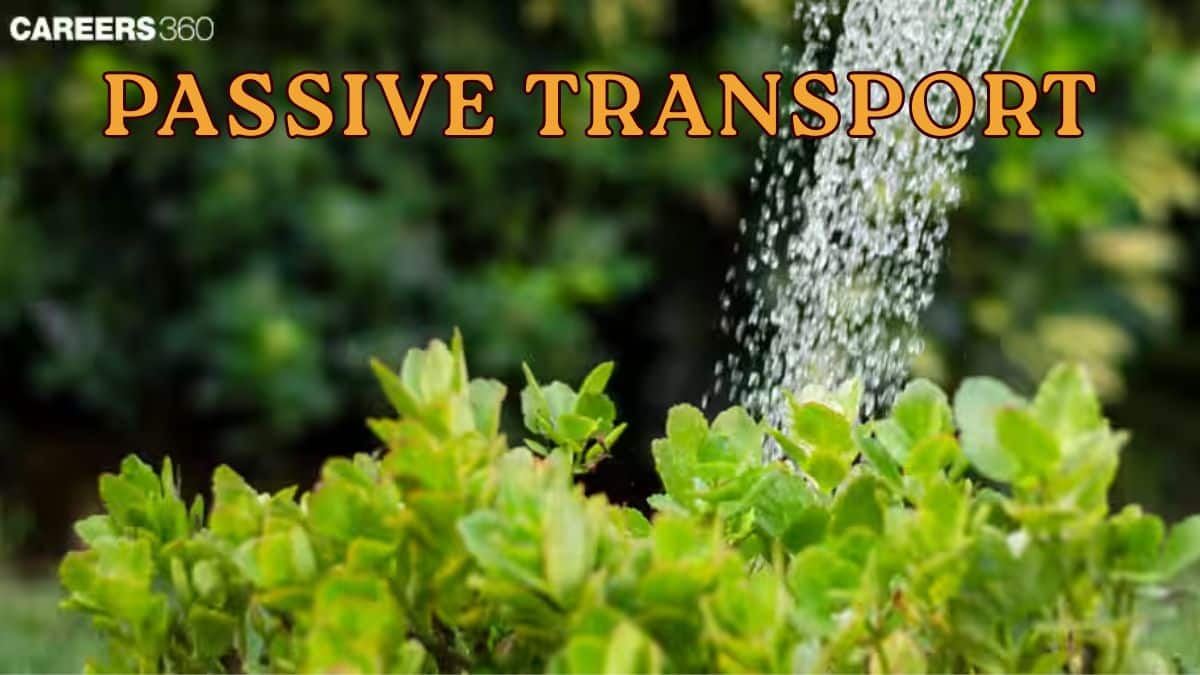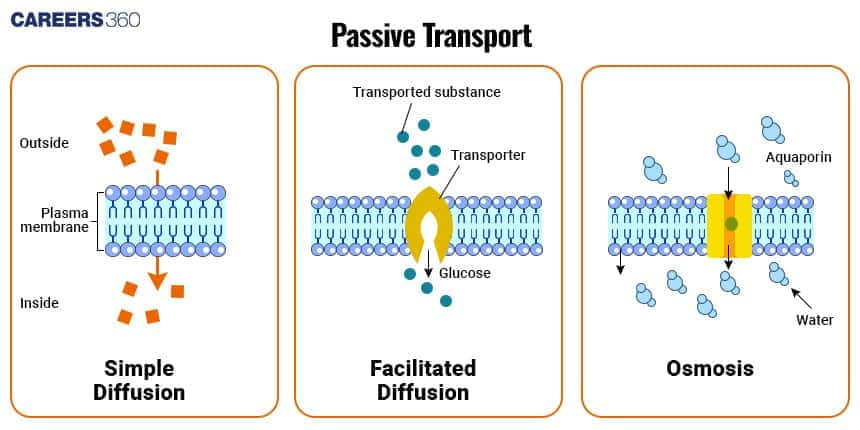Passive Transport: Definition, Overview, Types, Examples, Difference
Passive transport is a biological process where molecules move across a cell membrane without requiring energy. It helps maintain equilibrium and supports vital processes like gas exchange and osmosis. The key types include diffusion, facilitated diffusion, osmosis, and filtration.
This Story also Contains
- What is Passive Transport?
- Types of Passive Transport
- Factors Affecting Passive Transport
- Passive Transport in Prokaryotic and Eukaryotic Cells
- Examples and Applications of Passive Transport
- Passive Transport NEET MCQs (With Answers & Explanations)
- Recommended Video on Passive Transport

What is Passive Transport?
The transfer of molecules across cell membranes without energy input is called passive transport. It builds on the tendency of molecules, by diffusion, to move from an area of high concentration to an area of low concentration. Since no external energy is required in passive transport, it makes up a basic mechanism that helps the cell maintain equilibrium and carry out important functions.
Passive transport in biological systems is important in maintaining homeostasis as it allows the interchange of substances between a cell and its environment without expending energy. The basic principles involve concentration gradient, which means the difference in concentration between two regions. Movement down this gradient i.e., high to low concentration brings out the energy independence concept in passive transport.
Types of Passive Transport
Passive transport includes several means by which molecules travel through cell membranes :
Simple Diffusion
Movement of molecules from an area of high concentration to one of low concentration across a lipid bilayer.
The molecules move directly across the phospholipid bilayer of the membrane.
Examples: Oxygen and carbon dioxide exchange in lungs and tissues.
Facilitated Diffusion
It enables the movement of molecules that cannot directly go through the lipid bilayer.
Carrier proteins bind to specific molecules and have a conformational change to transport. Channel proteins form a pore through which specific ions or small molecules pass.
Examples: Glucose is brought into the cell via GLUT transporters.
Osmosis
The diffusion of water molecules across a selectively permeable membrane from an area of low solute concentration to an area of high solute concentration.
Water moves through aquaporins or directly through the membrane, thus equalizing solute concentrations on both sides.
It helps regulate cell volume and turgor pressure and also plays a crucial role in many cellular activities in the maintenance of cellular structure.
Example: uptake of water by plant roots, maintenance of water balance in red blood cells.
Filtration
The movement of water and solutes through a selectively permeable membrane due to hydrostatic pressure.
Hydrostatic pressure forces fluid and dissolved substances through porous membranes.
It is essential in processes like blood filtration in the kidneys, removing waste products while retaining larger molecules like proteins.
The table below shows the differences between the different types of passive transport:
Feature | Simple Diffusion | Facilitated Diffusion | Osmosis | Filtration |
Definition | Movement of molecules from high to low concentration | Movement of molecules down the concentration gradient through specific proteins | Movement of water through a semi permeable membrane from low to high solute concentration | Movement of of molecules through a membrane due to hydrostatic pressure |
Energy requirement | No energy | No energy | No energy | No energy |
Molecules Transported | O₂, CO₂, lipids | Glucose, ions, amino acids | Only water molecules | Water, salts, and small solutes |
Requirement of Proteins | No transport proteins involved | Require carrier or channel proteins | No transport proteins involved | No transport proteins involved |
Driving force | Concentration gradient | Concentration gradient | Water potential or osmotic gradient | Hydrostatic pressure |
Factors Affecting Passive Transport
The efficiency of passive transport can be affected by many factors:
Concentration Gradient
This is the difference in concentration of some substance in two different regions. The greater the difference in concentration i.e., the steeper the gradient, the faster the molecules will move from high to low concentration.
Temperature
The temperature increases the kinetic energy of molecules. Hence, raising the temperature increases the speed of the molecules. While the molecular speed increases, so does the rate of diffusion.
Molecule Size
Smaller molecules diffuse faster than larger ones since of their smaller size, they meet less resistance while diffusing across the medium. The larger the molecule, the less its ability to easily pass through the spaces, hence a slower diffusion rate. Also, lipophilic molecules readily pass through the lipid bilayer.
Transport Proteins
Facilitated diffusion only occurs in the presence of specific transport proteins that work correctly. The higher number of transport proteins elevates the diffusion rate. Saturation occurs because there are a limited number of carrier proteins. When molecules are high and the carrier proteins become occupied, the rate of transport cannot be increased further.
Nature of Medium
The nature of the medium through which transport takes place affects the rate too. In gases, the rate is higher because their density is lower and the movement of their molecules is more as compared to liquids and solids. In liquids, the rate is slow because the molecules are more closely packed and thus face more resistance.
Passive Transport in Prokaryotic and Eukaryotic Cells
The passive transport occurs in all cell types but differs in each:
Mechanism in Prokaryotes
Primarily, the simple and facilitated diffusion flow because of the simpler design of the cell.
Simple diffusion allows gases and small molecules to move across the plasma membrane without using energy.
Facilitated diffusion mediated by channel proteins or porins, helps in the transport of ions and nutrients in bacteria.
Mechanism in Eukaryotes
In eukaryotic cells, it involves more advanced mechanisms that include special proteins and organelles.
Passive transport regulates the exchange of substances such as oxygen, carbon dioxide, and water across the membranes.
Facilitated diffusion aids the movement of essential molecules like glucose and ions, ensuring cellular homeostasis without using ATP.
Plant vs Animal Cell
Plant cells often have extra mechanisms, including specialised transport proteins in vacuoles and cell walls, though these transport processes were much more dynamic and divergent in an animal cell.
Examples and Applications of Passive Transport
Passive transport plays a significant role in many physiological and ecological processes:
In Human Physiology (Gas exchange, filtration)
Oxygen and carbon dioxide diffuse across alveolar membranes during gas exchange.
Filtration processes in kidneys use passive transport to regulate blood and urine composition.
In Plants (Water uptake, nutrient transport)
The uptake of water by the plant roots occurs through the process of osmosis, which is important in transporting nutrients and turgidity pressure in plant cells.
The passive flow of nutrients through the plant tissues helps in maintaining the health and growth of plants.
Passive Transport NEET MCQs (With Answers & Explanations)
The key concepts to be covered under this topic for different exams are:
Types of Passive Transport
Factors affecting passive transport
Practice Questions for NEET
Q1. Water moves into the root hairs during passive absorption due to the _____ that takes place in the upper part of the plant.
Photosynthesis
Diffusion
Transpiration
Respiration
Correct answer: 3) Transpiration
Explanation:
Transpiration in the upper portion of the plant causes water to travel into the root hairs during passive absorption.
When water evaporates from the stomata of leaves, transpiration produces a pull. As a result, water flows upward via the xylem when the water pressure in the upper portion of the plant drops. By travelling from the higher water potential in the soil to the lower water potential inside the root hairs use osmosis to take water from the soil to replace the lost water.
Hence, the correct answer is option 3) Transpiration.
Q2. Which of the following molecules can enter the cell passively?
Water
Urea
Ca2+
Both 1 and 2
Correct answer: 4) Both 1 and 2
Explanation:
O2 and CO2, two small nonpolar molecules, readily dissolve in lipid bilayers and diffuse across them at high rates. Water and urea are examples of small, uncharged polar molecules that can diffuse through a bilayer as well, but considerably more slowly.
Option (1) is correct because water can enter cells passively.
Option (2) is correct because urea can enter cells passively.
Option (3) is incorrect because metal ions including Na+, K+, Mg2+, and Ca2+ are among the substances that are transferred via active transport across the cell membrane. Ion pumps or ion channels are needed to move these charged particles through membranes and throughout the body.
Hence, the correct answer is option 4) Both 1 and 2.
Q3. Passive absorption of water by the root system is the result of
Osmotic force in the shoot system
Tension on the cell sap due to transpiration
Forces created in the cells of the root
Increased respiratory activity in root cells
Correct answer: 2) Tension on the cell sap due to transpiration
Explanation:
Negative pressure from transpiration in the shoot system leads to the passive absorption of water in plants. As leaves lose water, osmotic pressure in the mesophyll cells increases, and thus it pulls water from the adjacent cells with tension. This tension tugs water out of the elements of the midrib of a leaf down through the stem, and lastly from the roots, which serve as passive pathways only to absorb water into the stem in an energy-saving mode.
Hence, the correct answer is option (2) Tension on the cell sap due to transpiration
Also Read:
Recommended Video on Passive Transport
Frequently Asked Questions (FAQs)
The flow of molecules across cell membranes is due to a concentration gradient, which doesn't need any energy input. That is passive transport.
Facilitated diffusion needs to transport proteins moving molecules across the cell membrane whereas simple doesn't.
Osmosis is the diffusion of water molecules across a selectively permeable membrane. It plays a very significant role in maintaining cell turgor and homeostasis.
Passive transport takes place in prokaryotic and eukaryotic cells. Examples include plant and animal cells.
These are the key factors which determine the rate of passive transport: concentration gradient, temperature, surface area, size of the molecules involved, their lipid solubility, and the availability of transport proteins.
